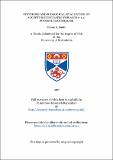Synthesis and biological evaluation of acceptor substrates for alpha-1,3-fucosyltransferase
Abstract
The chemical synthesis of sulfate and phosphate derivatives of galactose-α-1,4-N-acetylglucosamine-OR (octyl N-acetyllactosamine) and galactose-α-1,3-N- acetylglucosamine-OR [where R= -(CH2)7CH3] are reported here using N-acetylglucosamine and galactose as starting materials. Sialylation of octyl N- acetyllactosamine derivatives was achieved using trans-sialidase. These compounds were evaluated as potential acceptor substrates for five recombinant α-1,3- fucosyltransferases (α-1,3-FucT) and a semi-pure α-1,3/4-FucT (human milk). The kinetic data showed a wide range of acceptor specificities between different recombinant enzymes. Octyl N-acetyllactosamine 6-O-sulfate proved to be an excellent substrate for α-1,3-FucT VI, with a KM of 0.85 ?M. This substrate has a lower KM than any reported substrate for any α-1,3-FucT. An unusual result was observed for octyl N- acetyllactosamine derivatives containing a sulfate or phosphate group at the site of glycosylation. These compounds were found to be good acceptor substrates for α-1,3-FucT VI and milk α-1,3/4-FucT with KM and Vmax values similar to those of the parent compound, octyl N-acetyllactosamine. Preliminary studies show that the product of such a reaction could contain a sulfate or phosphate diester linkage between fucose and octyl LacNAc. If the anionic substituent at the site of glycosylation is being fucosylated, current models proposed for a mechanism involving an enzyme active site base mechanism cannot explain this result. An alternative mechanism has been suggested involving Mn2+ coordination to the hydroxyl group of the acceptor substrate being glycosylated. This mechanism can also be used to explain the unusual kinetic results obtained for substrates containing a sulfate or phosphate group at the site of glycosylation.
Type
Thesis, PhD Doctor of Philosophy
Collections
Items in the St Andrews Research Repository are protected by copyright, with all rights reserved, unless otherwise indicated.

